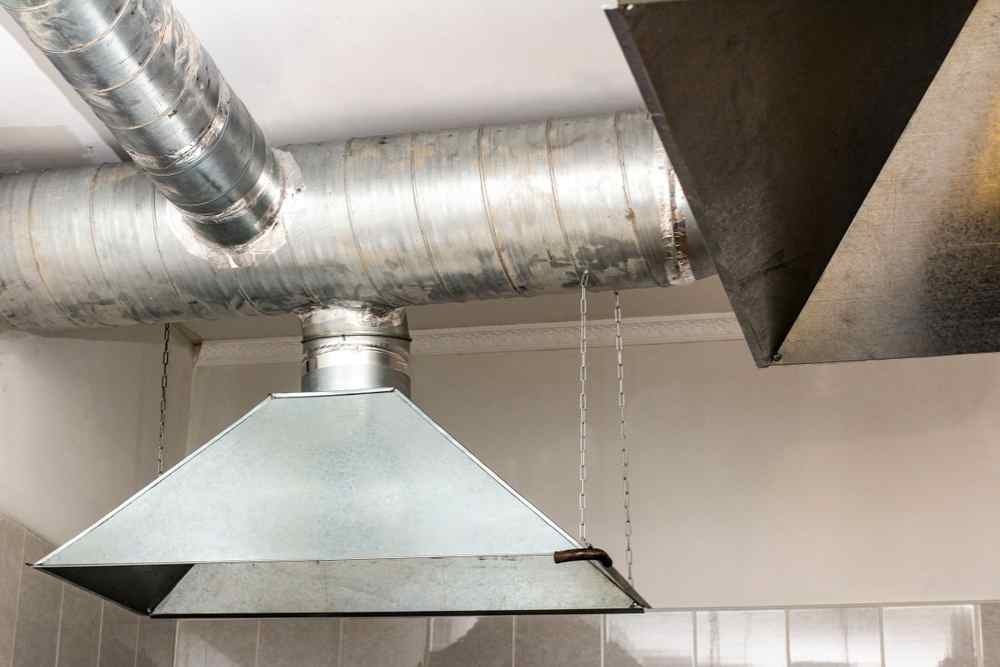Proper Ventilation for Kitchen Exhaust Cleaning

Proper ventilation is crucial for maintaining a clean and healthy kitchen environment. In commercial kitchens, where large amounts of food are prepared and cooked, the accumulation of grease and smoke can pose serious health and safety risks. This article will explore the importance of proper ventilation for kitchen exhaust cleaning, the potential consequences of inadequate ventilation, and the best practices for maintaining a clean and safe kitchen.
Ontario-wide Kitchen Exhaust and Hood Cleaning – Best prices and service guaranteed.
The Importance of Proper Ventilation
Proper ventilation plays a vital role in maintaining a clean and safe kitchen environment. It helps to remove smoke, odors, and airborne contaminants, such as grease particles, from the air. Without adequate ventilation, these pollutants can accumulate on surfaces, including walls, ceilings, and equipment, leading to a greasy and unhygienic environment.
Furthermore, inadequate ventilation can result in poor air quality, which can have detrimental effects on the health of kitchen staff. Exposure to high levels of airborne contaminants can cause respiratory problems, eye irritation, and even long-term health issues. It is, therefore, essential to ensure that kitchen exhaust systems are properly designed, installed, and maintained to provide effective ventilation.
Ontario-wide Kitchen Exhaust and Hood Cleaning – Best prices and service guaranteed.
The Consequences of Inadequate Ventilation
Failure to maintain proper ventilation in a commercial kitchen can have several negative consequences. These include:
- Fire Hazards: Accumulated grease in the exhaust system can become highly flammable, increasing the risk of fire. According to the National Fire Protection Association (NFPA), cooking equipment is the leading cause of fires in restaurants and commercial kitchens.
- Poor Air Quality: Inadequate ventilation can result in poor air quality, leading to discomfort and health issues for kitchen staff. This can result in decreased productivity and increased absenteeism.
- Unpleasant Odors: Without proper ventilation, odors from cooking can linger in the kitchen and spread to other areas of the establishment, creating an unpleasant dining experience for customers.
- Grease Buildup: Insufficient ventilation can cause grease particles to accumulate on surfaces, leading to a greasy and unhygienic environment. This can attract pests and compromise food safety.
Best Practices for Kitchen Exhaust Cleaning
Ontario-wide Kitchen Exhaust and Hood Cleaning – Best prices and service guaranteed.
To ensure proper ventilation and maintain a clean and safe kitchen environment, it is essential to follow best practices for kitchen exhaust cleaning. These practices include:
Regular Cleaning and Maintenance
Regular cleaning and maintenance of the kitchen exhaust system are crucial for its proper functioning. Grease buildup in the exhaust hood, ductwork, and fans should be removed at regular intervals to prevent fire hazards and maintain optimal airflow. The frequency of cleaning depends on the volume of cooking and the type of food being prepared. It is recommended to consult local regulations and industry standards for specific guidelines.
Professional Cleaning Services
Ontario-wide Kitchen Exhaust and Hood Cleaning – Best prices and service guaranteed.
While regular cleaning by kitchen staff is important, it is also advisable to hire professional cleaning services for a thorough and comprehensive cleaning of the kitchen exhaust system. Professional cleaners have the expertise, equipment, and knowledge to effectively remove grease and ensure compliance with safety standards. They can also identify and address any potential issues that may compromise the ventilation system.
Proper Installation and Design
Proper installation and design of the kitchen exhaust system are critical for effective ventilation. The system should be designed to capture and remove smoke, grease, and odors efficiently. It should include components such as exhaust hoods, ductwork, fans, and filters that are appropriate for the size and volume of the kitchen. Consulting with a professional ventilation engineer during the design and installation process can help ensure optimal performance.
Ontario-wide Kitchen Exhaust and Hood Cleaning – Best prices and service guaranteed.
Regular Inspections
Regular inspections of the kitchen exhaust system are essential to identify any issues or deficiencies that may affect its performance. Inspections should include checking for grease buildup, inspecting the condition of the exhaust hood and filters, and testing the airflow. Any problems should be promptly addressed to prevent potential hazards and maintain proper ventilation.
Case Study: The Importance of Proper Ventilation
A case study conducted by a leading restaurant chain highlights the importance of proper ventilation for kitchen exhaust cleaning. The chain had been experiencing frequent grease fires in their kitchens, resulting in property damage and disruption of operations. Upon investigation, it was found that the exhaust systems in many of their locations were poorly designed and inadequately maintained.
The company took immediate action to address the issue by implementing a comprehensive ventilation maintenance program. This program included regular cleaning by professional services, increased frequency of inspections, and staff training on proper cleaning procedures. As a result, the number of grease fires significantly decreased, and the overall kitchen environment became cleaner and safer.
Ontario-wide Kitchen Exhaust and Hood Cleaning – Best prices and service guaranteed.
Proper ventilation is essential for maintaining a clean and safe kitchen environment. Inadequate ventilation can lead to fire hazards, poor air quality, unpleasant odors, and grease buildup. By following best practices for kitchen exhaust cleaning, such as regular cleaning and maintenance, hiring professional services, proper installation and design, and regular inspections, commercial kitchens can ensure effective ventilation and minimize the risks associated with inadequate ventilation. Investing in proper ventilation not only protects the health and safety of kitchen staff but also enhances the overall dining experience for customers.
Learn more about “Questions to Ask Professional Kitchen Exhaust Cleaners” here.
Frequently Asked Questions about Proper Ventilation for Kitchen Exhaust Cleaning

What are the essential aspects of proper ventilation for kitchen exhaust cleaning?
Proper ventilation is crucial when undertaking the task of kitchen exhaust cleaning, primarily to ensure the safety of the individual performing the cleaning, as well as to facilitate effective cleaning. Adequate air circulation prevents the build-up of potentially harmful fumes and particles released during the cleaning process. Ensure windows and doors are open, or use exhaust fans that vent to the outdoors. If you’re using chemical cleaning agents, read the manufacturer’s guidelines regarding ventilation needs. In commercial settings, specialized ventilation systems may be used to capture and remove pollutants. Always ensure that the ventilation system is operational and in good condition before you start cleaning.
Is it safe to use a residential ventilation system while performing kitchen exhaust cleaning?
Residential ventilation systems, including range hoods and kitchen exhaust fans, are generally not designed to handle the high concentrations of chemicals and fumes produced during a deep cleaning process. While they may provide some level of air circulation, they are insufficient for effective ventilation in this scenario. It’s advisable to rely on natural ventilation by opening windows and doors or using additional portable fans to direct fumes and particles out of the workspace.
How do professionals ensure proper ventilation during kitchen exhaust cleaning?
Professional kitchen exhaust cleaning companies often use industrial-grade ventilation systems specifically designed for this purpose. These systems are far more effective than typical residential ventilation systems and are capable of capturing and removing even the smallest particles and chemical fumes. Professionals also make use of personal protective equipment like masks and gloves and adhere to strict safety standards that include proper ventilation protocols. Moreover, they are trained to recognize signs of inadequate ventilation and take corrective measures promptly.
Can improper ventilation during kitchen exhaust cleaning cause health issues?
Absolutely, improper ventilation can lead to a host of health problems. Fumes and particles released during cleaning can be harmful if inhaled, leading to respiratory issues and allergic reactions. There may also be a risk of chemical exposure, particularly if you are using chemical-based cleaning agents without adequate ventilation. Always prioritize safety by ensuring that you are working in a well-ventilated space, wearing the necessary protective gear, and following all safety guidelines.
How can I assess if my workspace is adequately ventilated for kitchen exhaust cleaning?
Before you start the cleaning process, take a moment to assess the workspace. If you’re in a confined space with limited airflow, make sure to open windows and doors, if possible. Turn on any available exhaust fans that vent outdoors. You can also use smoke or a light piece of tissue to visually check air movement. If the smoke or tissue moves steadily toward the open windows or exhaust outlets, it’s an indicator of good ventilation. If you’re using chemical cleaning agents, read and follow the manufacturer’s recommendations for ventilation to ensure you’re in compliance with safety guidelines.
Proper ventilation is critical when it comes to kitchen exhaust cleaning. Whether you’re handling this task in a residential setting or you’re a professional in the field, adhering to best practices for ventilation can safeguard health and improve the effectiveness of your cleaning efforts.
- hood cleaning
- kitchen exhaust cleaning
- Proper Ventilation for Kitchen Exhaust Cleaning
- restaurant hood cleaning






